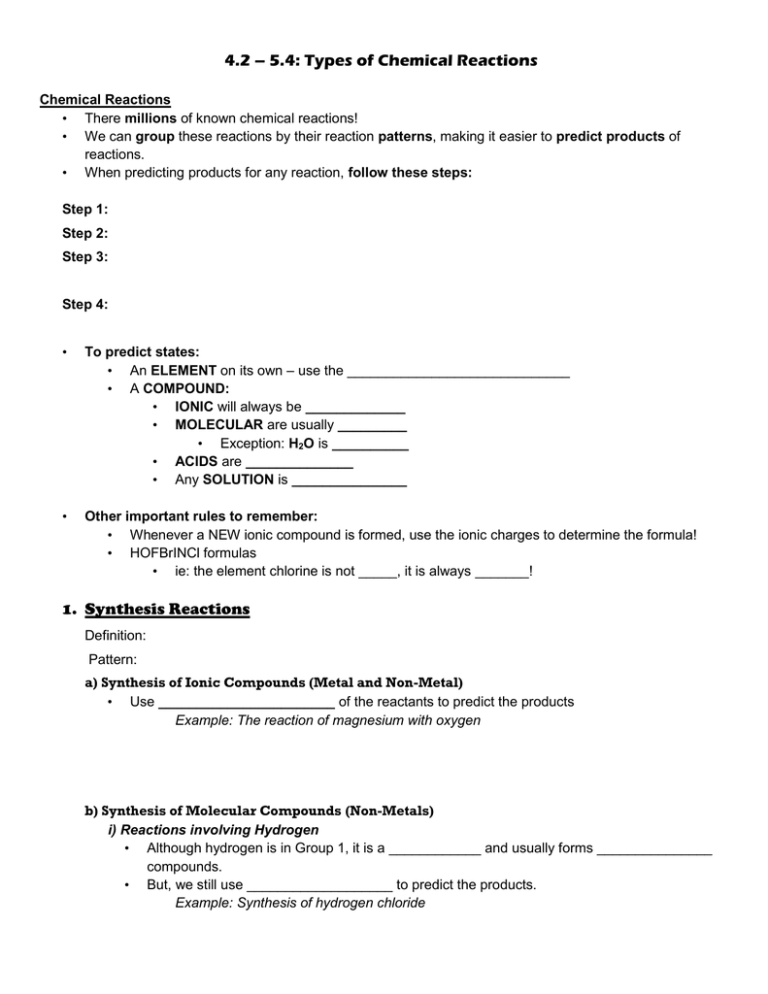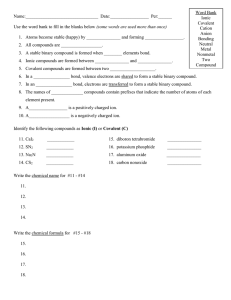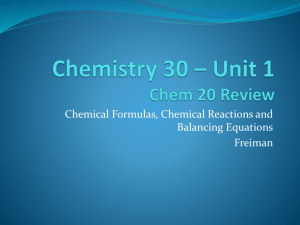4.2 – 5.4: Types of Chemical Reactions
advertisement

4.2 – 5.4: Types of Chemical Reactions Chemical Reactions • There millions of known chemical reactions! • We can group these reactions by their reaction patterns, making it easier to predict products of reactions. • When predicting products for any reaction, follow these steps: Step 1: Step 2: Step 3: Step 4: • To predict states: • An ELEMENT on its own – use the _____________________________ • A COMPOUND: • IONIC will always be _____________ • MOLECULAR are usually _________ • Exception: H2O is __________ • ACIDS are ______________ • Any SOLUTION is _______________ • Other important rules to remember: • Whenever a NEW ionic compound is formed, use the ionic charges to determine the formula! • HOFBrINCl formulas • ie: the element chlorine is not _____, it is always _______! 1. Synthesis Reactions Definition: Pattern: a) Synthesis of Ionic Compounds (Metal and Non-Metal) • Use _______________________ of the reactants to predict the products Example: The reaction of magnesium with oxygen b) Synthesis of Molecular Compounds (Non-Metals) i) Reactions involving Hydrogen • Although hydrogen is in Group 1, it is a ____________ and usually forms _______________ compounds. • But, we still use ___________________ to predict the products. Example: Synthesis of hydrogen chloride ii) Reactions not involving Hydrogen • Difficult to predict the products. They often depend on the reaction conditions. • Only way to identify the products is by chemical tests. • For our purposes, simply ______________________________________________________ Example: the synthesis of sulfur trioxide c) Synthesis Reactions involving oxides i) Acidic oxides • ____________react with _____________ to form ___________________________________ Example: The synthesis of carbon dioxide • Then, when dissolved in __________, non-metallic oxides produce ____________ solutions (the oxyacid that corresponds to the original non-metal is formed) Example: Carbon dioxide reacts with water ii) Basic oxides • ___________ react with ______________ to form __________________________________ Example: Sodium and oxygen • Then, when dissolved in ______________, metallic oxides produce _____________ solutions (The metal combines with hydroxide) Example: Sodium oxide reacts with water Practice! a) Show the synthesis of calcium oxide. Then, show the reaction when it reacts with water. b) Show the 2 step synthesis of sulfuric acid. 2. Decomposition Reactions Definition: Pattern: a) Simple Ionic or Molecular Compounds • The compound breaks down into its ________________ Example: Decomposition of potassium chloride Example: Decomposition of ammonia b) Complex Compounds • A compound breaks down into two ____________________ • Often difficult to predict, except: • Carbonates decompose into a ___________________ and ________________ Example: The decomposition of calcium carbonate Example: The decomposition of lithium carbonate 3. Single Displacement Reactions Definition: Pattern: Example: Zinc reacts with copper (II) sulfate Example: Bromine reacts with magnesium oxide The Activity Series of Metals • Not all single displacement reactions “on paper” actually occur. It depends on the ________________ of the two metals. • The Activity Series is a list of metals and their reactivity. (see handout) • The most reactive metals are on ______________ • An element (on its own) can only displace another element (in a compound) if it is __________________________ (________________ on the activity series) • • Otherwise, ______________________________ occurs The farther apart two elements are, the _______________ the reaction a) Reactions Involving a Metal and an Ionic Compound • Use the activity series to determine if a reaction occurs • If reaction occurs, write the products • If no reaction occurs, just write NO REACTION. Example: Magnesium metal is placed in a solution of copper (II) sulfate Example: Lead is placed in a zinc nitrate solution b) Reactions Involving a Metal and Water or Acid (H+) • Same idea as above: Hydrogen is also on the activity series **Treat acids and water as if they are ionic compounds (with an H+) Example: Lithium is added to sulfuric acid Example: Sodium is added to water c) Reactions Involving a Non-Metal • Halogens have their own activity series – follows group pattern Example: The reaction of chlorine and potassium iodide 4. Double Displacement Reactions Definition: Pattern: ** Like replaces like (metals switch places) Recall: Solubility • Solution - • Solute – • Solvent – • Solubility – • (aq) – • (s) – a) Precipitation Reactions (Two ionic compounds) • Reactions between two compounds don’t ALWAYS happen. It depends on their solubility. • If a precipitate forms, a reaction occurs, because one of the new compounds is ____________________ in the solution of the other compound. • If no precipitate forms, there is ________________ • How do we determine if a precipitate forms? USE the ______________________ (see handout) • Practice: Determine if the following compounds are soluble (aq) or insoluble (s) in water: a) AgCl b) MgCl2 c) Na2CO3 d) BaSO4 Example: Solutions of potassium chloride and silver nitrate are combined. Example: Solutions of potassium sulfate and iron (III) chloride are combined. b) Reactions that Produce a Gas • Double displacement reactions involving an ________ can produce ________________. Gases may be produced in two ways: 1. Directly Example: a metal sulfide will produce hydrogen sulfide gas Gases formed: Sulfides H2S Carbonates CO2 Sulfites SO2 2. Indirectly - an unstable product can decompose into __________ and _________ Example: A carbonate Example: A sulfite c) Neutralization Reactions i) With a hydroxide compound Pattern: Acid has _______, base has _______ - these ions combine to form ______________________ Other cation and ion combine to form a ___________ (ionic compound) Example: Hydrochloric acid and sodium hydroxide ii) With a carbonate compound Pattern: Example: Calcium carbonate reacts with sulfuric acid to produce carbonic acid: But, carbonic acid immediately decomposes into water and carbon dioxide The chemical equation for the net reaction of calcium carbonate and sulfuric acid is: 5. Combustion Reactions Definition: • A chemical reaction in which____________ burns in _____________ • Common fuels are ________________________ with the general formula _____________ Methane is ___________, propane is ______________ • Releases energy in the form of __________ and ___________ a) Complete Combustion Formula: • Occurs when there is ________________________________ • Products are ______________________________________________________________ • The ________ way to burn a fuel – it produces the ____________________________________ • The __________________on a gas stove is an example of complete combustion Example: Burning of natural gas, CH4 b) Incomplete Combustion Formula: • Occurs when the oxygen supply is _______________ • Products are _________________________________________________________________ • The _________________________________________ is an example of incomplete combustion • There are many ____________________________________ related to incomplete combustion Example: Incomplete combustion of heptane, C8H18, a hydrocarbon in gasoline Practice: Compare the complete and incomplete combustion of propane, C3H8.





